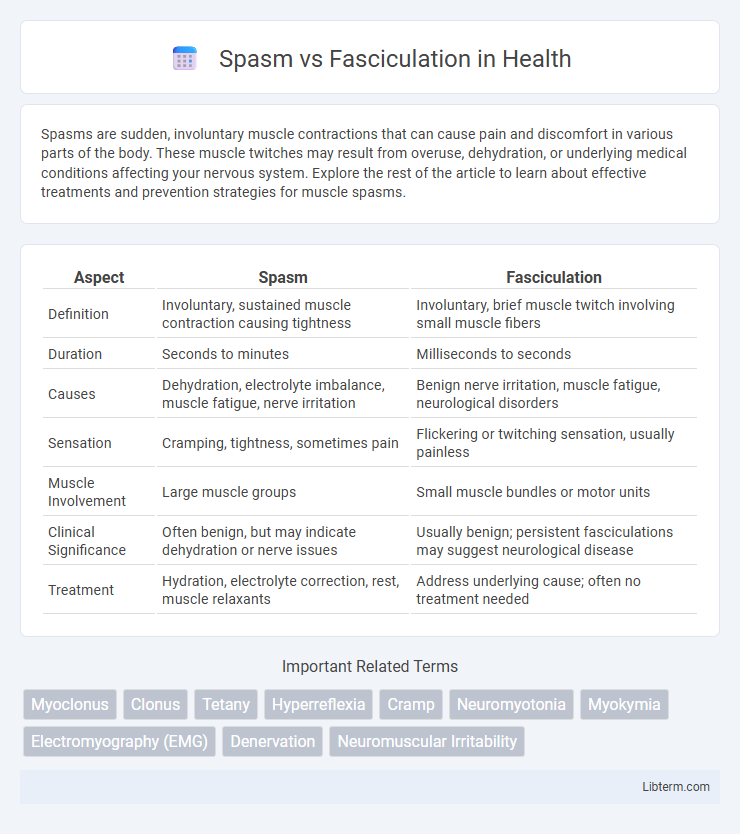Spasms are sudden, involuntary muscle contractions that can cause pain and discomfort in various parts of the body. These muscle twitches may result from overuse, dehydration, or underlying medical conditions affecting your nervous system. Explore the rest of the article to learn about effective treatments and prevention strategies for muscle spasms.
Table of Comparison
| Aspect | Spasm | Fasciculation |
|---|---|---|
| Definition | Involuntary, sustained muscle contraction causing tightness | Involuntary, brief muscle twitch involving small muscle fibers |
| Duration | Seconds to minutes | Milliseconds to seconds |
| Causes | Dehydration, electrolyte imbalance, muscle fatigue, nerve irritation | Benign nerve irritation, muscle fatigue, neurological disorders |
| Sensation | Cramping, tightness, sometimes pain | Flickering or twitching sensation, usually painless |
| Muscle Involvement | Large muscle groups | Small muscle bundles or motor units |
| Clinical Significance | Often benign, but may indicate dehydration or nerve issues | Usually benign; persistent fasciculations may suggest neurological disease |
| Treatment | Hydration, electrolyte correction, rest, muscle relaxants | Address underlying cause; often no treatment needed |
Introduction to Spasm and Fasciculation
Spasms are sudden, involuntary muscle contractions that can cause pain or discomfort and often result from muscle fatigue, dehydration, or nerve irritation. Fasciculations are small, involuntary muscle twitches involving individual motor units, typically visible under the skin and caused by nerve damage, stress, or certain neurological conditions. Differentiating between spasms and fasciculations is crucial for accurate diagnosis and treatment in neuromuscular disorders.
Defining Spasm: Key Characteristics
Spasms are sudden, involuntary muscle contractions that can be painful and vary in duration from a few seconds to several minutes. They typically affect larger muscle groups and are often caused by muscle fatigue, dehydration, or nerve irritation. Unlike fasciculations, which involve small, localized muscle fiber twitches visible under the skin, spasms result in more forceful and sustained muscle tightening.
Understanding Fasciculation: Essential Features
Fasciculations are involuntary, fine muscle twitches caused by spontaneous discharge of motor neurons, typically visible under the skin but painless. Unlike spasms, which are sustained muscle contractions often linked to cramps or pain, fasciculations do not result in muscle tightening or limited movement. Recognizing fasciculations is crucial in diagnosing neuromuscular disorders such as amyotrophic lateral sclerosis (ALS) and benign fasciculation syndrome, where their pattern, frequency, and associated symptoms guide clinical evaluation.
Causes of Spasm
Muscle spasms often result from dehydration, electrolyte imbalances such as low potassium or magnesium, and overuse or injury of the muscle fibers. Neurological conditions like multiple sclerosis or spinal cord injury can also trigger involuntary spasms by disrupting nerve signals. In contrast, fasciculations typically arise from benign nerve irritation or motor neuron diseases and involve small, visible muscle twitches rather than sustained contractions.
Causes of Fasciculation
Fasciculations are caused by spontaneous activation of muscle fibers due to hyperexcitability of motor neurons or peripheral nerve irritation, often linked to conditions like benign fasciculation syndrome, nerve damage, or electrolyte imbalances such as low magnesium or calcium. Unlike spasms, which are caused by involuntary muscle contractions triggered by muscle fatigue or dehydration, fasciculations result from abnormal nerve signals rather than muscle fatigue. Common causes include nerve root compression, motor neuron disease, or side effects of medications affecting nerve function.
Clinical Differences: Spasm vs Fasciculation
Spasms are involuntary muscle contractions characterized by sustained, often painful tightening of muscles, typically involving larger muscle groups, whereas fasciculations are smaller, fine muscle twitches caused by spontaneous discharge of motor units, usually visible under the skin without muscle movement. Clinically, spasms present with stiffness and restricted range of motion, commonly linked with muscle fatigue, dehydration, or neurological conditions like multiple sclerosis. In contrast, fasciculations are benign in many cases but may indicate motor neuron disease if persistent and accompanied by muscle weakness or atrophy.
Symptoms and Presentation
Muscle spasms are involuntary contractions that cause sudden, painful tightening and stiffness, often affecting larger muscle groups with a sustained, intense sensation. Fasciculations present as small, rapid, involuntary muscle twitches visible under the skin, typically painless and localized to a specific area. Spasms often impair movement due to rigidity, whereas fasciculations rarely interfere with muscle function and are more indicative of nerve irritation or lower motor neuron involvement.
Diagnostic Approaches
Diagnostic approaches for spasms and fasciculations primarily involve clinical evaluation, electromyography (EMG), and nerve conduction studies. EMG helps differentiate spasms, which are sustained muscle contractions, from fasciculations, characterized by brief, involuntary muscle fiber twitches. Advanced imaging, blood tests for electrolyte imbalances, and neurological assessments further support accurate diagnosis and underlying condition identification.
Treatment Options
Treatment options for muscle spasms typically include the use of muscle relaxants, physical therapy, and hydration to alleviate sudden, involuntary contractions. Fasciculations may require addressing underlying nerve conditions through medications like anticonvulsants or magnesium supplements, with electromyography used for precise diagnosis. Both conditions benefit from lifestyle adjustments, such as stress management and avoiding stimulants, to reduce frequency and severity.
When to Seek Medical Attention
Muscle spasms are sudden, involuntary contractions that often resolve with hydration and rest, while fasciculations are fine, involuntary muscle twitches usually harmless but potentially linked to neurological conditions. Seek medical attention if spasms persist beyond a few days, are severe, or accompanied by muscle weakness, numbness, or swelling. Prompt evaluation is critical if fasciculations spread, increase in frequency, or come with muscle weakness, as these may indicate underlying disorders like amyotrophic lateral sclerosis (ALS) or peripheral neuropathy.
Spasm Infographic

 libterm.com
libterm.com